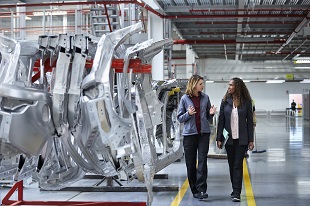Future-proofing engineering: four critical skills areas shaping the future of the industry
Explore how digital transformation, sustainability, workforce diversity and future talent development are driving change across the sector – and why it’s essential to invest in these areas.
29 October 2024
The engineering sector employs 6.3 million people in the UK, accounting for almost a fifth of all UK jobs – and this number is only set to go up. The demand for engineering and technology jobs is expected to continue to grow at a higher rate than other occupations.
Whether it’s aeronautical, manufacturing or nuclear, the engineering sector is an exciting place to be. Engineering professionals have opportunities to work with new technologies and be a key player in the push to reach net zero. However, with an ageing workforce and significant skills gaps, the sector still has work to do to make sure it’s a thriving and attractive industry for existing and future employees.
Thankfully, the industry seems to be ready to commit to the skilling and reskilling journey. Speaking to employers and decision makers for our new Making Skills Work: The Path to Solving the Productivity Crisis report, we found a reassuring readiness to invest in skills development. Following our conversations we identified different mindsets across different sectors, with the engineering sector having a ‘leaning in’ approach and acknowledging that investment in skills is vital to keeping pace with sector demands.
To support this necessary skills development, we have picked out four key areas for the industry and its stakeholders to focus on to ensure that engineering continues to thrive.
1. Closing digital skills gaps
While any working engineer will have many job-specific technical skills that have been honed over multiple years, with the evolution of technology and expanding role of AI, up-to-date digital skills are a necessity across the sector.
The Engineers 2030 report from The Royal Academy of Engineering includes data and digital fluency as one of its six key principles for engineering knowledge, skills and behaviours, commenting that:

“As the world becomes ever more digital, the ability to find solutions within it increasingly requires the ability to manage, work with, and apply digital and data technologies – ranging from cybersecurity and coding to data models and artificial intelligence.”
The demand for increased digital capabilities is reflected across the training landscape – from
comprehensive CAD courses to support the development of key design skills to the incorporation of digital skills as part of both the core content and the occupational specialisms in each of the
engineering T Levels.
2. Preparing for a more sustainable future
With government net zero targets to meet and sustainability high on the agenda, it’s time for the engineering industry to go green. According to EngineeringUK this process is already well underway with a 55% increase in the number of adverts for ‘green engineering jobs’. But in order to meet the infrastructure demands that come with these sustainability targets, significant training and upskilling will be required.
There are expected to be up to 725,000 new jobs needed by 2030 to meet UK net zero targets, and both current professionals and those entering the industry need the green skills and knowledge to succeed in these roles.
In addition to specific green qualifications, engineering apprenticeship knowledge, skills and behaviours (KSBs) now include sustainability components, ensuring that individuals beginning and progressing their engineering careers are ready to succeed in a new, greener engineering sector.
3. Attracting young people to the industry
In order to reduce the skills and workforce shortages impacting the sector, engineers, employers and key organisations need to find ways to show the benefits and opportunities of a career in engineering to young people. Interest in STEM subjects needs to be nurtured from primary age, while parents and teachers need to have a better understanding of the career options available.
 Organisations like Neon, an EngineeringUK initiative, deliver resources designed to introduce STEM careers to children in primary and secondary education but this work needs to be supported by the existence of clear progression routes for young people who want to be engineers.
Organisations like Neon, an EngineeringUK initiative, deliver resources designed to introduce STEM careers to children in primary and secondary education but this work needs to be supported by the existence of clear progression routes for young people who want to be engineers.
In MakeUK’s Maker’s Manifesto published before the 2024 UK general election, growing and developing future talent in manufacturing was identified as a priority objective for the new Labour government. At the time of publication, the majority of organisations in the sector viewed existing support for skills development as inadequate and there had been a 38% decrease in manufacturing and engineering apprenticeships since the introduction of the Apprenticeship Levy.
By hiring an apprentice, employers in the sector can help people at the start of their careers develop the skills they need in a real working environment. Businesses can hire apprentices to fill vital roles in their organisations from the moment the apprenticeship begins, supporting the apprentices’ development and helping to shape the future of both the business and the whole industry.
For organisations looking to deliver shorter placement-based work experience there are 13 T Level engineering specialisms, each of which requires a 45-day placement. By offering a T Level placement, employers across all sub-sectors have the opportunity to get involved in kickstarting young engineers’ careers.
4. Building a diverse workforce
For the engineering sector to successfully solve its personnel issues and prepare for the future, it will need to start attracting a more diverse workforce. The engineering and technology workforce has slightly lower proportions of disabled people, people from ethnic minority groups and people from lower socio-economic backgrounds than the UK workforce as a whole and this disparity is even more significant for women in engineering.
 According to EngineeringUK, only 15.7% of the people currently working in engineering or technology are women, in spite of women accounting for 48% of the total UK workforce. This is a gap that will need to be addressed in order to use the untapped potential available and meet rising skills and workforce demands.
According to EngineeringUK, only 15.7% of the people currently working in engineering or technology are women, in spite of women accounting for 48% of the total UK workforce. This is a gap that will need to be addressed in order to use the untapped potential available and meet rising skills and workforce demands.
These gaps are frequently emerging early with girls being less likely to choose STEM subjects at A Level than boys, something that has a knock-on effect down the line. New pathways like T Levels offer opportunities to learners who may not traditionally have considered themselves as potential engineers as Alison Ackroyd, Technical Teaching Fellow at the Education and Training Foundation explained at the Fellowship Awards.
“If you don’t naturally come from a background where you have those contacts or have that science capital then areas like T Levels are amazing… [T Levels] add science or social capital that other courses have not been able to do before.”
Whether it’s through T Levels, apprenticeships or short qualifications, employers and training providers have an exciting opportunity to shape a vital industry, delivering jobs and opportunities to existing and future engineers.
Find out more about our engineering provision
Fill out our expression of interest form to get involved in our employer activity